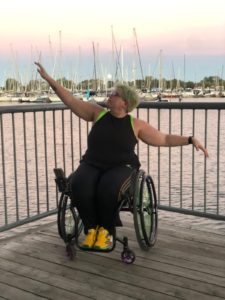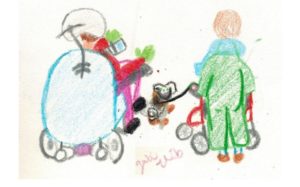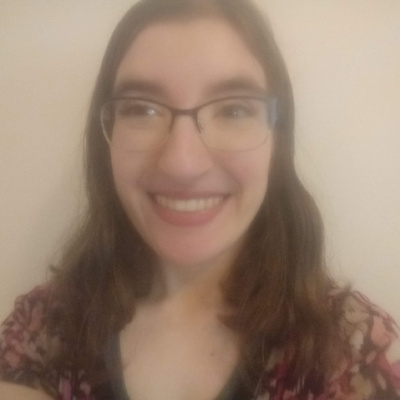Making Access Values Accessible: Switch Up Your Organization With Shay Erlich
As circus companies look to bring disabled people into their casts and audiences, they turn to accessibility strategies and tools. But meeting everybody’s needs requires new approaches— and looking at access from a new perspective. Speaking from their experience, accessibility consultant and disabled artist Shay Erlich offers these organizations some access starting points… as well as a deeper crash course.
Accessibility matters—but the ways we understand accessibility matter, too, as do the ways we talk about it. Every day, more and more disabled voices make themselves heard in public venues. They share their stories and speak up about their needs—and more and more organizations are taking notice. Those in the circus and live entertainment industries are no exception. But even as organizations broaden their scope and strive to open up their work—and their companies—to new kinds of audiences and artists, they do not always know where to begin… or even where to start the conversation. That’s where accessibility consultant Shay Erlich (they/them) enters the scene.

In every avenue of their work—creator, performer, art instructor, consultant—access values are close to Shay’s heart. A genderqueer, multiply disabled, and hard-of-hearing artist, they have firsthand experience on both sides of the discussion table. For more than a decade, they’ve worked with organizations around Ontario, Canada, as a professional consultant, helping these companies rethink and revamp their accessibility strategy from the ground up and forge new systems that fulfill the needs of their community. And whether Shay is designing new, immersive artwork or co-helming The Cyborg Circus Project and helping young, disabled movement artists in Toronto find career success, their love of art and service shine through; they always have their own community in the forefront. No matter what career hat they wear, their approach comes from a place of experience, education, and empathy.
We asked Shay a few questions to glean their insights on accessibility from both a consultant’s and a disabled artist’s perspective. Here’s what they had to say:
Based on your experience as a consultant, about what percentage of organizations do you think have a good grasp on accessibility strategies? How could this number be improved?
Personally, I don’t think that percentages are a useful benchmark. One way that organizations can know if they have a good grasp on accessibility strategies is to take a look at the conversations and engagements that they are having with the disability community. Are disabled people openly visible throughout the organization, including in staff and leadership positions?
Given that more than 25% of the US population meets the threshold to identify as disabled, any organization that engages with four people or more (as staff, audience, etc.) should be having ongoing, active conversations about accessibility, both internally and externally. If you look out at your audience base and supporters and disabled people aren’t present, then you likely aren’t doing enough to make them feel welcomed and included. If disabled people aren’t in positions of leadership within your organization, what is preventing them from being in those positions?
By getting perspective on where you’re currently at, what you are doing well, and where you have places that you could be doing better, it’s easy to find a starting point to improve your organization’s grasp on accessibility strategies.
What obstacles might prevent organizations from implementing accessible strategies? Is it plain ignorance, or is there more to it than that?
From my experience, generally the biggest barrier that organizations face is a lack of understanding that ableism is deeply entrenched in the foundational structures of organizations. Many organizations have great values and want to be inclusive and welcoming, but their policies, procedures, and programs don’t reflect that intent.
A lot of organizations currently understand accessibility as something that gets added on at the end of a project, or if someone specifically requests a particular accommodation. When you are adding in access as one of the last points on a project, it limits how those who provide access can do their jobs, especially when a small tweak earlier in the process might have made something much more accessible or cost-effective. Without developing an understanding of how ableism has shown up within a project long before we present a work to an audience or offer a program to the community, we can’t help but create programs and audience experiences that don’t fully meet people’s needs.
What are the biggest things that organizations neglect when it comes to working with disabled artists?
One of the areas that I’ve struggled with a lot as a performer is finding places to present my work that embrace my accessibility values as a disabled performer. Whenever I perform, I want to feel as though it is an invitation to my community to come out and see my work.
I’ve often felt as though I’ve had to compromise my access values on projects, or act as an accessibility consultant on top of my role as an artist to ensure that my community can even have accurate accessibility information about the show that I am participating in. This type of dynamic can lead to disabled artists feeling like they have really divided loyalties between being able to have their work seen—and potentially grow their careers because of it— or staying true to their own values, accepting that they will produce less work than other artists, and probably get to show their work substantially less frequently than their non-disabled peers. As an artist, I can’t bring my best creative work to an organization if I am having to use a lot of my time and energy educating them on how to execute access for myself and my community.
Shay, you are a circus artist yourself; you’ve worked with companies on creative projects as well. Can you speak to your experiences on that front? How can the organizations you work with meet your needs as a performer?
One thing that is important is recognizing that needs are contextual. I don’t have one universal set of access needs that would easily translate into something like a generic accessibility rider, that I could send everyone before confirming an artistic project. I need different things for a two-week performance run than I need for a one-off engagement.
The more information that organizations can provide me in advance about their working processes, timing, procedures, etc., the more accurate the information I can give them about what my needs will be, and if we can find something that will work for all of us within the scope of the production. Being able to have all of these conversations as early as possible makes it a lot easier to ensure that we all have everything we need for a successful working relationship.
Speaking of the performing arts, what are the basic accessibility tools for event providers to offer their audiences, both in live venues and online spaces?
One of the first basic accessibility skills that organizations need to develop is the capacity to articulate and accurately identify the accessibility features each event will offer. Not every organization is going to be able to address every access need every single time. It’s important to articulate accurately what you are able to do.
For example, in the era of integrated auto-captioning on Zoom, many organizations are offering live captioning for their events for the first time through auto-caption features. It is important for organizations to know that using auto-captions is not the same thing as providing professional captioning through a CART [Communication Access Realtime Translation] writer, and that they need to clearly mark which kinds of captions will be present on their events. As well, in older cities, where venues are frequently up stairs or buildings lack other basic physical accessibility features, being able to identify the features of a particular venue in the event marketing and promotion is far more meaningful than making a generic statement such as, “Unfortunately, this venue is not wheelchair accessible.” Knowing the specifics allows each person to make their own decisions about what types of accessibility are critical for them, and whether or not they feel okay to attend an event as it currently exists.
When organizations are seeking to expand the accessibility of their events and programs, there is no one-size-fits-all approach as to which access features should come first. This is where it is critical to hire disability and accessibility consultants, who can help guide you on what makes the most sense within your local context.

As a creator, how do you approach accessibility in your own art?
As a creator, I am mindful that when I am creating accessible art, it is something multidimensional and multimodal by necessity. Each access feature is another opportunity for artistic excellence and creativity; it is an opportunity to consider another dimension of the world or story that is being developed and conveyed. I focus extensively on the central artistic question of the work, and how that question can be interpreted through various mediums, such as the visual elements; the narrative made accessible to audiences through their ears, or through their bodies; and how written text can add an additional dimension to a piece. Rather than thinking of accessibility as an add-on to the work, accessibility itself becomes part of the artistic process, and the work lives in multiple dimensions.
If you had just one piece of advice for a circus company that is about to hire a disabled artist, what would it be?
I strongly believe that organizations that are hiring disabled artists should always hire an additional disabled person to support the process. So much of the time, disabled artists are expected to be in dual consultant/artist roles and educate the hiring organization on their own needs and on their audience’s. That all becomes a significant burden, and disabled artists are virtually never recognized or compensated for the time they spend on these tasks. In intentionally splitting the roles, you let the artist focus on their skill and craft, and another person can support your organization to ensure that you are getting it right throughout the process.
Psst… want to borrow a page or two from Shay’s book (and you’re not in Canada)? For the first time, organizations outside Ontario can join Shay in the online realm for their “Accessibility 101 for Organizations” workshop, happening from 1 to 5 pm on June 29th, 2022. They’ll offer a great starting place for organizations that are looking for a touchstone to assess their current practices and policies in working with disabled folks, and some steps you can take right now to become more accessible. Don’t miss out! For more information or to register, check out Shay’s website.
Image of Shay credited to photographer Taj Grewal
Do you have a story to share? Submit your news story, article or press release.







